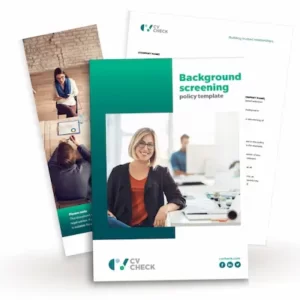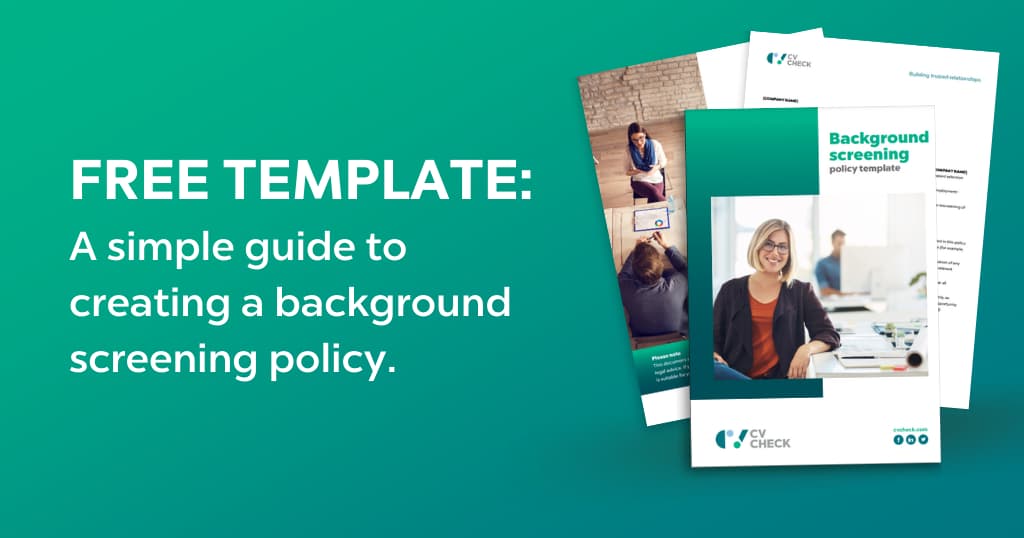You asked, and we listened…
At CVCheck our customers often wonder about background screening policies – why are they important? What should they include? How do I go about writing one?
To make life simple for hiring managers and recruiters, we’ve created a concise, robust background screening policy that can be downloaded and tailored to suit any business. This article answers your questions on what a solid policy should include, and why.
Why do you need a background screening policy?
Policy writing may seem dull, and even intimidating, however a sound background screening policy is an essential document for any business looking to select top talent while complying with industry-relevant constraints.
Regulatory requirements, licence verifications, police and criminal history checks and more may be necessary to turn a candidate into your newest employee.
Not only does a robust policy ensure you meet industry regulations, it’s also a great way to ensure consistency is maintained across your recruitment and HR processes. If your organisation is yet to create a background screening policy, this easy-to-follow guide and convenient downloadable template is made for you.
What is a background screening policy?
In a nutshell, a background screening policy outlines how and why you should conduct checks on potential new hires, contractors and existing employees.
A background screening policy will help you achieve a streamlined process that is time- and cost-efficient, guarantees fairness and consistency, and establishes trust with the people within your business.
What are the benefits of creating a policy?
The biggest benefit of creating any policy is that it outlines a clear, standardised approach. For background screening, this means there is a physical reference and helpful training tool for anyone involved in the hiring process.
A sound background screening policy is also the smartest way to reduce risk. Every business wants to minimise its risks – this includes reducing risks when hiring new employees and ensuring current employees remain fit to perform their roles.
From the childcare centre that needs to verify working-with-children certifications, to the building firm that needs a highly qualified site manager, to the financial institution that needs to ensure their CFO has never been bankrupt – a clear-cut, holistic background screening policy gives your hiring managers a specific guide to follow.
The outcome? Less risk.
What should you include in your policy?
Your background screening policy needs to be relevant to your organisation, and align with your hiring practices, desired hiring outcomes and industry-specific regulatory requirements. It’s also important to consider the specific risks your business and industry is exposed to.
With the above in mind, the most robust background screening policies will include the following (please download our background screening policy template for an example of how to word each section).
1. Purpose and scope
This section should clearly explain the document’s purpose, which in a nutshell is to verify a candidate, existing employee or contractor’s credentials and criminal background so that you can hire with confidence and meets compliance requirements.
The scope of your document refers to who in the organisation the policy applies to. In most cases, this should include all potential new employees, all existing employees and contractors.
2. Privacy and confidentiality
It’s important to be clear on how an individual’s information will be handled. In doing so, you build confidence and trust with the people you engage.
With this in mind, this section should clearly communicate your company’s commitment to keeping all candidates’ information secure, as required by relevant state and/or federal law. It should outline your company’s responsibility when it comes to obtaining consent to conduct background checks, and explain what the company will do with any information sourced once the checks have been completed.
3. Company’s responsibilities
Communicate who is responsible for making sure the background screening policy is implemented (this could range from the Talent Acquisition or HR manager in a large organisation, to the business owner in a small business). It should also highlight who is ultimately responsible for ensuring the policy is consistently applied company-wide. This removes any ambiguity regarding where responsibility for the policy’s application lies.
4. Procedure for pre-employment screening
This section should clearly outline, in order, the steps taken to conduct background screening on a candidate or new independent contractor. This includes:
- The person within the company who will be conducting/ordering the checks
- At what stage during the hiring process checks will be conducted
- How and when the candidate will be contacted for permission to conduct checks
- What happens if the candidate refuses to give permission for screening
- How background screening results are handled, including in the case of ambiguous or unsatisfactory results
- When the candidate will be provided with copies of their background checks
- How hiring decisions based on checks are communicated to candidates
Clearly communicating your background screening process to new candidates establishes a trusting, transparent and open relationship right from the get-go.
5. Rescreening of existing employees
In addition to new employees you should also conduct regular re-screening of existing employees. Why? Re-screening minimises your company’s exposure to risk. It allows you to maintain updated records, stay up-to-date with any potential regulatory and/or legislative requirements, and continue to verify information obtained in the employee’s initial background checks.
For example, is your employee’s criminal record still clear? Are their qualifications still up to date? Is your employee entitled to continue work under their visa restrictions?
This section needs to explain why existing employees are re-screened, how regularly they’ll be re-screened and the circumstances in which re-screening will be conducted (for example, if they’re promoted or re-assigned to a new role).
6. Procedure for re-screening employees
Similar to section 4, this section should provide a step-by-step procedure for re-screening people within your organisation. This includes:
- Informing an employee of your intentions to re-screen, and gaining consent to do so
- What happens if the candidate refuses to give permission for re-screening
- How background screening results are handled, including in the case of ambiguous or unsatisfactory results
- When the candidate will be provided with copies of their background checks
- How decisions based on checks are communicated to employees
7. Assessing risk levels within your company
Use this section to communicate your company’s tolerance to risk, which will determine what checks are needed for individual roles within your company. It will also determine the actions you take following any potential unsatisfactory background screening check results.
There are a number of factors that influence risks to your business. These include, but are not limited to:
- The physical environment in which you work
- The regulations and legislation that govern your industry
- The roles that need to be filled so that your business and teams can operate successfully
- The people you choose to hire
To determine where the risks to your organisation lie according to each role, and which checks are necessary to mitigate those risks, ask yourself questions such as:
- Does the role require the employee to have the right to work in your given country?
- What are the consequences of employing someone who doesn’t have the right to work in this country?
- Does the role require the employee to operate a vehicle?
- Does the role require the employee to have contact, either direct or indirect, with vulnerable members of the community?
- Does the role require the employee to have specific qualifications, licenses and/or memberships?
- Does the role require the employee to have access to company finances?
- Does the role require the employee to have access to company databases or sensitive company systems?
- Does the role require the employee to have access to dangerous materials?
- Does the role require the employee to be customer-facing?
- Will the person become a leader within your organisation?
- Is the role a senior executive (C-suite) or board member role?
If you are unsure of what background screening products you need, click here to book a free consult – we’re always happy to help you assess what risk looks like for your organisation.
8. Assessment of screening results
This section needs to communicate clearly how screening results will be assessed, and what happens in the event concerns are raised. It’s important to note that if there are concerns, that doesn’t necessarily mean a candidate will be disqualified from the hiring process, or have their current employment terminated.
9. Next policy review
Like all policies, your background screening policy needs to be reviewed regularly to ensure its application continues to suit your company.
For example, the company may have expanded to include different types of roles or geographic regions. Or the regulations and legislation governing your industry may have changed. Use this section to publically commit to a policy review date.
When in doubt, seek legal expertise
While mid-sized and larger businesses will likely have dedicated HR and legal teams to rely upon when creating new policies, smaller businesses often don’t have that expertise on hand. This can create potential risks when designing new policies, particularly those that dictate hiring practices and how candidates should be screened.
If there’s ever any doubt, it’s always advisable to have a legal professional look over your final policy document.
Still not sure where to start?
We’ve done the hard yards for you and created a simple, robust background screening policy that can be customised to suit your organisation. Jump in!
NB: The above policy template is intended for information purposes only and does not provide legal advice. If you’re unsure if this information, or your interpretations of it, is suitable for your business and circumstances, seek legal advice.





